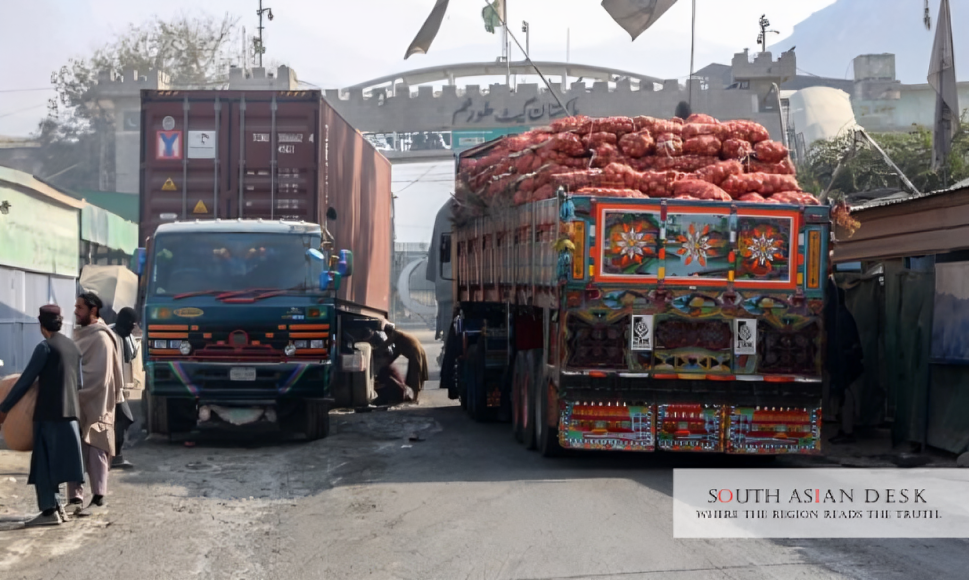Kabul, Afghanistan – The Ministry of Industry and Commerce announced on Wednesday, September 24, 2025, that Afghanistan trade volume for the first half of the solar year 1404 reached more than $6.783 billion, marking a 30% rise compared to the corresponding period in 2023.
This growth, driven by increased imports and modest export gains, underscores efforts to bolster regional ties, though experts highlight the need for diversification to address a persistent trade imbalance. The announcement, made in Kabul, reflects policy reforms aimed at stabilising the economy post-2021, with projections suggesting continued expansion in Afghanistan trade volume 2025 if barriers ease.
In South Asia, where interconnected economies face geopolitical strains, Afghanistan’s 30% rise in trade signals potential for enhanced cross-border commerce, benefiting neighbours like Pakistan and India through shared routes. Yet, it also amplifies regional vulnerabilities, as import dependency could strain balances of payments and heighten inflation risks across the subcontinent.
Surge in Afghanistan Trade Volume 2025
The latest figures from the Ministry of Industry and Commerce reveal a robust uptick in Afghanistan’s overall economic exchanges. For the period from April to September 2025 – aligning with the first six months of the Afghan solar calendar – the total Afghanistan trade volume 2025 stood at $6.783 billion.
This represents a significant 30% increase over the $5.225 billion recorded in the same timeframe the previous year. According to the Ministry, the growth stems from streamlined customs procedures and expanded access to Central Asian markets, though imports dominated the expansion.
Exports contributed $748 million to this total, achieving a 9% year-on-year growth from $686 million. Key commodities driving this segment included raisins, figs, cotton, apricots, saffron, pistachios, grapes, beverages, and other agricultural products.
These goods were primarily shipped to destinations such as China, India, Pakistan, the United Arab Emirates, Kazakhstan, Turkmenistan, and Iraq. In contrast, imports totalled $6.035 billion, surging 21% from the prior period, with an additional $1.042 billion in value attributed to essentials like petroleum products, textiles, and construction materials sourced mainly from Iran, the UAE, and Pakistan.
Akhundzada Abdul Salam Jawad, spokesperson for the Ministry of Industry and Commerce, stated: “The main export products include raisins, figs, cotton, apricots, saffron, pistachios, grapes, beverages, and other agricultural goods, which are exported to China, India, Pakistan, the United Arab Emirates, Kazakhstan, Turkmenistan, and Iraq.”
This official commentary highlights the role of agricultural exports in bolstering Afghanistan trade volume 2025, even as global demand for organic produce – a strength of Afghan goods – remains untapped due to certification hurdles.
Afghanistan Trade 30% Rise 2025: Imports Lead the Charge
The 30% rise in Afghanistan trade for 2025’s early months is largely propelled by import growth, reflecting heightened domestic demand amid economic stabilisation. Data from the Ministry indicates that consumer goods imports jumped 30% year-on-year, accounting for 40% of the total inbound volume.
This escalation aligns with broader trends reported by the World Bank in its August 2025 Economic Monitor, which notes a 36.35% overall trade growth for Afghanistan compared to global averages, driven by a stronger Afghani currency and improved regional logistics.
However, this import-heavy expansion has widened the trade deficit to approximately $5.287 billion for the half-year, up from earlier projections. Analysts attribute this to external factors, including a 84% year-on-year increase in sourcing from Iran, which now holds a 30% share of imports. Waseem Safi, CEO of the Chamber of Agriculture and Livestock, emphasised quality standards: “Afghan agricultural goods are either organic or semi-organic. The world currently demands organic products – meaning everything is natural and free from chemical additives. However, standards in our exports are very important, and work must be done in this regard.”
Cross-verification with World Trade Organisation data confirms the import surge, with Afghanistan’s total merchandise imports reaching $8.568 billion for the full year to date, while exports lag at $870 million. The UK Government’s trade factsheet for Q1 2025 further corroborates modest bilateral flows, reporting a UK-Afghanistan trade value under £10 million, underscoring the dominance of regional partners in shaping Afghanistan trade volume 2025.
Export Challenges Amid Growth
Despite the overall 30% rise in Afghanistan trade, exports face headwinds from non-tariff barriers and competition. Pakistan’s recent tariffs on Afghan textiles, for instance, contributed to a 14% drop in that sector to $242 million, per Comtrade figures. Food exports, however, rose 4% to $1.31 billion, buoyed by China’s tariff exemptions.
Economic analyst Ahmad Firdous Behgzain observed: “The more we can strengthen our economic ties with neighbouring countries, the higher our national economic growth will be. There is a need to participate in both international and national conferences and to have an active presence in meetings between the government and the private sector.”
The Chamber of Agriculture and Livestock has called for investments in international certification to unlock markets for semi-organic produce, potentially adding $200 million to annual exports if achieved by year-end.
Background
Afghanistan’s trade landscape has evolved significantly since 2021, with total volume exceeding $12 billion in 2024 – a 38% import increase offset by a 4% export dip, according to the Ministry’s year-end statement. This sets the stage for 2025’s projected trajectory, where the Afghanistan trade 30% rise builds on prior gains in agriculture and mining.
Historical data from the Observatory of Economic Complexity shows exports consistently below 15% of total trade, highlighting structural dependencies. The World Bank’s March 2025 Monitor projects a 2.6% GDP growth for the year, partly linked to these trade dynamics, though deflationary pressures (at -0.3% YoY in February) could temper momentum.
What’s Next
Looking ahead, sustaining the Afghanistan trade volume 2025 momentum will hinge on diversifying exports and easing border frictions, with potential for a full-year figure approaching $14 billion if regional pacts like the Lapis Lazuli corridor advance. Officials anticipate further gains in the second half, contingent on harvest yields and global commodity prices.
Published in SouthAsianDesk, September 25th, 2025
Follow SouthAsianDesk on X, Instagram, and Facebook for insights on business and current affairs from across South Asia.






